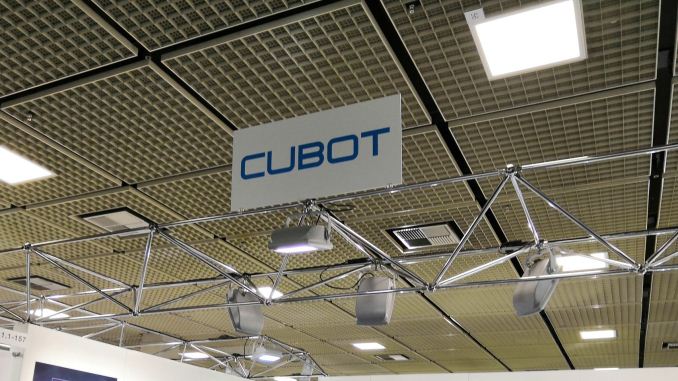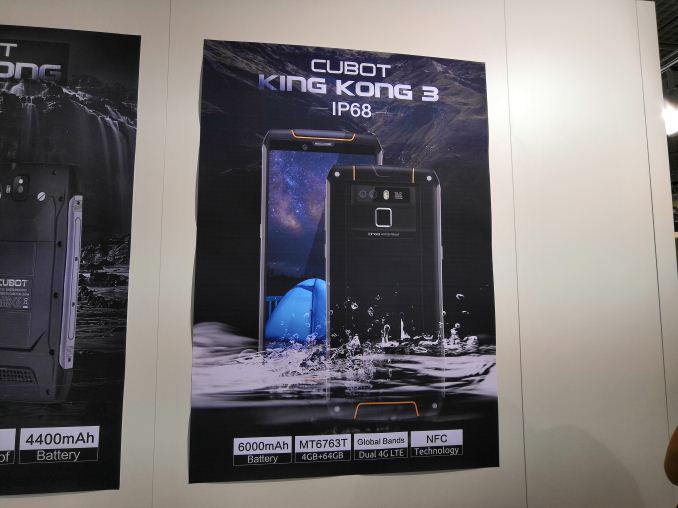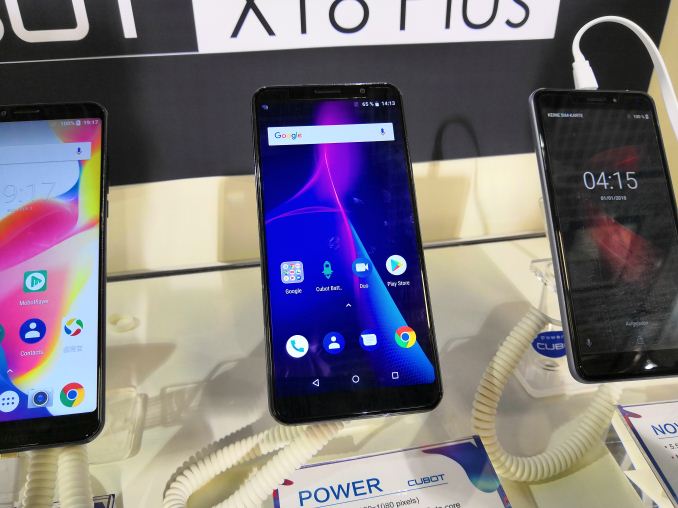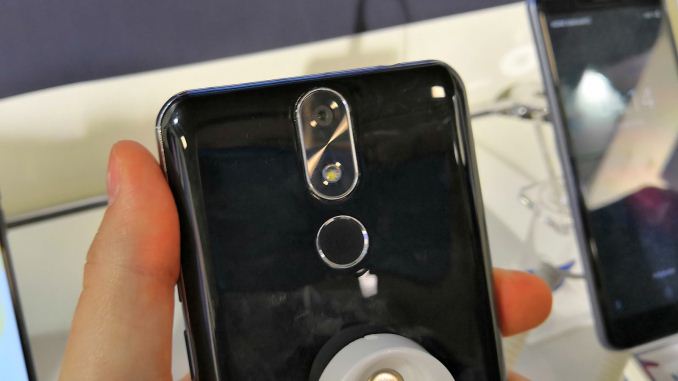CUBOT's New 6000 mAh Smartphones: Who Calls a Smartphone King Kong?
by Ian Cutress on September 17, 2018 1:00 PM EST- Posted in
- Smartphones
- Trade Shows
- POWER
- CUBOT
- IFA 2018
- King Kong

Readers may remember that back in 2015, I wrote a review about a $150 smartphone I picked up from Amazon called the Cubot H1. This unit was a cheap Chinese phone, running a low-end quad core SoC and paired with a low resolution screen, which was designed to excel in a single area: battery life. Having a smartphone that could last almost a week was great. Since then, I had never come across the brand at a show, until this year at IFA, where they had a small booth to try and expand into Europe with their new devices.
There were two main devices on display: the Power, which is somewhat of a successor to the H1, and the King Kong 3.
King Kong 3
Unfortunately Cubot did not have this device on display, but this is going to be their new flagship: a high-end Mediatek MT6763T processor (8xA53), IP68-rated device with a 6000 mAh battery and simultaneous dual 4G LTE. This builds on their first generation King Kong (for some reason there isn’t a King Kong 2), with a ruggedized design focusing on the ability for construction workers to drop the phone and for it still to work, hence the King Kong name.
Here are some images of the King Kong (1), as they did have that on display. The King Kong 3 is expected to have a similar design.
If we head on over to the Cubot website, you’ll notice that the webpage for the King Kong line is full of standard King Kong imagery – in actual fact, what looks like direct imagery from the King Kong movie from 2005, just flipped left to right. Now the name is a bit odd (I guess it kind of fits with a durable phone) but it was my understanding that someone holds the license for the King Kong brand? I’d be highly surprised if Cubot was licensing the brand with those rights owners.
Cubot Power: POWWWERRRRR
So here’s a device that’s more up my street. It looks like a high-end smartphone, with a 6-inch full-screen display running at 2160x1080. It uses the same MT6763T SoC as the King Kong 3, but it offers a 6 GB DRAM and 128 GB storage. It also mirrors the KK3 in that it has a 6000 mAh battery, but it's without the rugged design, so it is actually easier to hold and use on a day-to-day basis.
There is a bit of a sneaky design on the rear, as it looks like it has two cameras, but one of those spots is just the LED flash. The rear camera is a 20MP unit, while the front camera is 13MP. The device does support two SIM cards, although only one can be in 4G mode. Meanwhile there is also a microSD card slot that can support another 256 GB of storage.
The Power is set to hit the street at around $260, which is considerably more than the H1 I purchased back in the day. At the minute I carry around my LG V30, which handily has wireless charging, and an Honor phone for its AI camera, but both of them struggle to get through a full day of my ‘active’ use without charging. I wonder if I can make do with a high-capacity mid-range phone again without all those bells and whistles?













27 Comments
View All Comments
marees - Monday, September 17, 2018 - link
I have Lenovo P2I charge it 'only' once in 2 days. The fast charger is fast enought to charge the 5000 mah battery in less than 2 hours
also as a bonus, I can use the front touch sensor as an all in one button that enables one finger use
Mumrik - Monday, September 17, 2018 - link
I imported a P2 specifically for the very big battery combined with a power-sipping midrange SOC.It's exactly what I hoped it would be.
redpen - Monday, September 17, 2018 - link
I've got an H1 back when you recommended it, it's been quite the adventure. I don't know if you've ever found out, but the thing had two screen protectors on. It was pretty surprising to peel the second one off to have these scratches I put up with for a year disappear.In terms of quality, I've dropped the thing a million times and the screen is fine, and it doesn't pick up scratches like the screen protector. The glue is coming apart, the volume buttons have fallen off, and the power is soon to follow suit. Speakers are toast after a steamy shower. Battery is still great, sometimes I only charge it once a week but then again I only use it as an alarm, and reading material when taking a dump.
Software side, it's always been laggy, I could barely play fgo, it's on the verge of being usable, definitely not a phone you can go back to after a flagship. I can't wait for this thing to die, but at the same time there's no phone with good software support at the entry price point.
I'd like to see some investigation done on android one, to see if it really is delivering on the promise, or pushing iffy patches.
Diji1 - Tuesday, September 18, 2018 - link
>there's no phone with good software support at the entry price pointI don't think you looked very hard.
Every Xiaomi phone gets updates. My Sharp Aquos S2 gets updates.
satai - Monday, September 17, 2018 - link
> high-end Mediatek MT6763T processor (8xA53)WTF? 8*A53 is high-end?!
cfenton - Monday, September 17, 2018 - link
Maybe Ian means it's high-end for Mediatek? It's not their highest end Helio (which is the P60), but it's probably second or third.satai - Tuesday, September 18, 2018 - link
Helio X.. is the higher-end brand (higher considering Mediatek abilities). Helios P.. are their mid-range.Mumrik - Monday, September 17, 2018 - link
Unless Mediateks suddenly became as energy efficient as Qualcomms it's still stuck in the same contradiction many of these Chinese monster battery phones are - awesome battery + power-hungry SOC.Lolimaster - Monday, September 17, 2018 - link
At this point in time, they should start using 4xA55.abufrejoval - Monday, September 17, 2018 - link
Bigger batteries also mean a bigger risk.One of my sons is a volunteer firefighter and works as a coast guard during summers. So instead of going for the high-end--like the rest of the family--he wanted a phone built like a tank, that could take a beating and serve as a torch or a hammer if need be, so he got himself a Blackview BV6000S using a similar recipe: Big battery, middle-class SoC, IP68 rating and a tough metal jacket for an outdoor exterior.
Perhaps he enjoyed a little too much dropping it on concrete floors in front of the shrieking girls, who guard their Samsungs and iThingies better than their virtue, but eventualy after a week of duty on the coast of the Baltic sea, the phone, or rather the battery inside wanted to go expansive... but couldn't within the confines of the phone's metal straight-jacket.
I told him to switch and leave it off and we were about to do as full a backup as anyone can do on a phone not rootable, but he made the mistake to leave it on the charger over night.
Somewhere in the wee hours of the morning, it exploded.
No, no, nothing interesting (he likes his fires!), more like diphteria.
Lithium batteries come with platic sealing. That sealing ist designed for flexibility, so that the gases that can develop as a batteries aims for a supernova afterlife, are safely contained within.
That's why good smartphones developed by engineers have a plastic back-cover that is even removable. Unspeakable iThingies and their fiendish imitators use metal, ceramics or even glass to give you "the edge".
In this case the frame was so sturdy, the only way of escape was through the hole left in the chassis to connect SIM and SDcard to the PCB. And through that hole went all the pent-up gas/fluid combination as it punched through the plastic foil, which was designed to sustain an overall 2:1 or perhaps as much as a 4:1 expansion across the entire battery's surface, but not within that tiny SD+microSIM cutout... something like the Amdahl's corollary of explosion.
The SIM did not make it. Nor did any of the on-board electronics. The SD-card did, however, and he was ever so happy all those photographic memories of a teenager's summer had come to rest there, not in the part that died as part of the "better user experience".
On the upside, the phone got replaced. It took about 6 months because exploed phones were a tad unpopular after that "Samsung Summer" and even with surface transport Customs needed a lot of assurance the "new" phone was actually a repair unit.
On the downside, even the replacement phone's battery soon started started to act up, perhaps because of what he does or how he goes about it.
I have been hunting for a replacement using the 10nm process size to double the run-time, instead of a bigger battery. But as it turns out, the 10nm middle-class isn't really there yet, while 2017th high-end is eight where the 10nm would be in terms of pricing, only so much better in terms of value.
So I've just managed to rooted a Nokia 8, which he'll get as a birthday present, that offers perhaps even better up-time using a 10nm Snapdragon 835 with just a 3000mAh battery than a 22nm Mediatek could offer at 6000mAh (and much worse performance).
Just like in real-life, the middle class is getting ... over so I'd recommend you not go there.